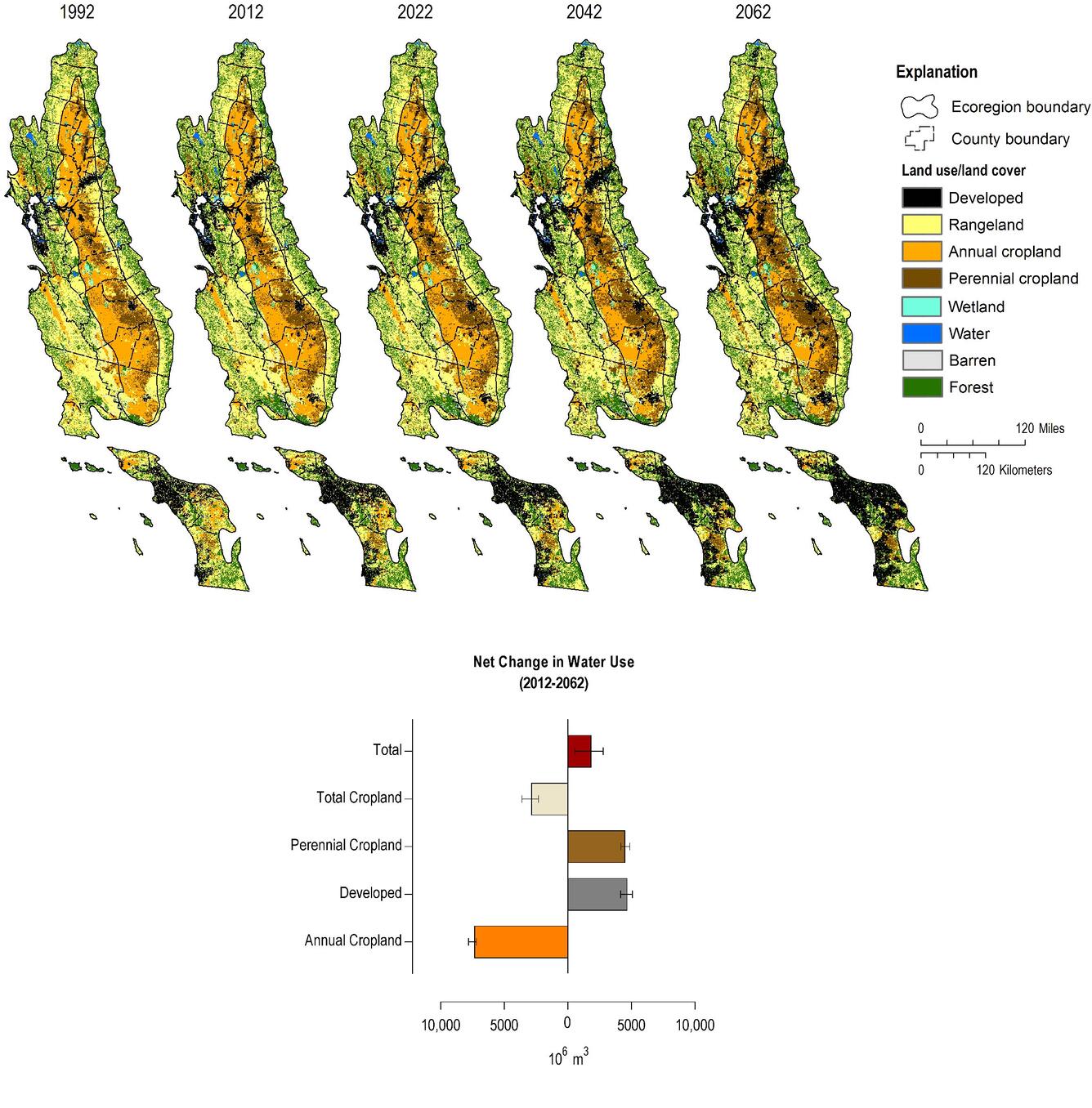If past patterns of California land-use change continue, projected water needs by the year 2062 will increase beyond current supply.
If past patterns of California land-use change continue, projected water needs by the year 2062 will increase beyond current supply. If historical trends of land use changes to or from urban, agricultural or other uses continue, the result will be increased water-use demand beyond what existing supplies can provide. Large uncertainties associated with weather and climate variability have the potential to exacerbate the problem.
Scientists with the U.S. Geological Survey and the Nature Conservancy calculated historical trends of land-use change, urbanization, agriculture expansion and contraction from 1992 to 2012, and then used those trends to project future land-use patterns and water demand from 2012 to 2062 in California’s Central Valley and foothills, Central Coast and South Coast. These new projections are detailed in the paper, “Future land-use related water demand in California” published this week in the journal Environmental Research Letters.
Assuming no new storage, efficiency or technology is created to improve California’s water supply, the study results indicate that the current 25 percent urban water-use restrictions called for in Governor Edmund G. Brown’s Executive Orders B-29-15 and B-37-16 would need to be maintained through 2062 for future water demand to remain at or below 2012 demand, unless restrictions were put in place on other water uses. Water use in 2012 was already proven unsustainable given the ongoing multi-year drought, which led to mandated statewide urban-use restrictions in 2015.
In the long term, drought, highly variable rainfall from year to year, and the real possibility of future warming and drying of climate combine to create potential water supply limitations. Coupled with population increases and shifting agricultural practices (from annual crops to orchards and vineyards) there can be enormous uncertainty in planning for future water supply and demand.
“Modeling the future based on historical trends is not a prediction of what will happen, though patterns do emerge that can help guide water-use policies,” said Tamara Wilson, USGS research geographer and lead author of the study.
“In many ways, the recent drought is prologue to confronting the challenges that climate change presents for all of us. The reality is California’s water demands outpace supply, and the precipitation this winter did not change that,” said co-author Dick Cameron, Associate Director for Science, Land Conservation Program at the Nature Conservancy in California. “Assuming a ‘business-as-usual’ scenario of future land-use change, we show that the current pattern of increasing development and additional perennial cropland (orchards and vineyards) will lead to loss of grassland habitat and increased water use.”
Projecting land-use change data for California over the 50 years from 2012 to 2062 revealed the following potential changes:
- Large increase in urban area: 2 million acres of newly developed land cover over 50 years – a net increase of 40,000 acres a year – the equivalent of adding an area just larger than the city of Stockton each year.
- Large amount of grassland habitat loss of 1.1 million acres over 50 years, despite continued protection at the historical rate. This loss will also exacerbate challenges in preserving and recharging aquifers.
- An overall 4 percent increase in water supply demand (applied water) within the study area due to urbanization and expansion of orchards and vineyards.
- Large shifts from annual to perennial crops, which removes flexibility in irrigation demand during drought. While annual-crop water demand dropped 30 percent, perennial-crop demand increased 37.5 percent. Given the difference in area between these types, net agricultural water demand decreased nearly 8 percent over current demand.
- There will be a large shift toward developed-land water uses from the agriculture sector: Urban water use in 2062 is projected to increase to 27 percent of overall water use in the study area (from 18 percent in 2012).
- A net increase in overall projected water use in 38 of the 46 California counties in the study area by 2062.
Get Our News
These items are in the RSS feed format (Really Simple Syndication) based on categories such as topics, locations, and more. You can install and RSS reader browser extension, software, or use a third-party service to receive immediate news updates depending on the feed that you have added. If you click the feed links below, they may look strange because they are simply XML code. An RSS reader can easily read this code and push out a notification to you when something new is posted to our site.




